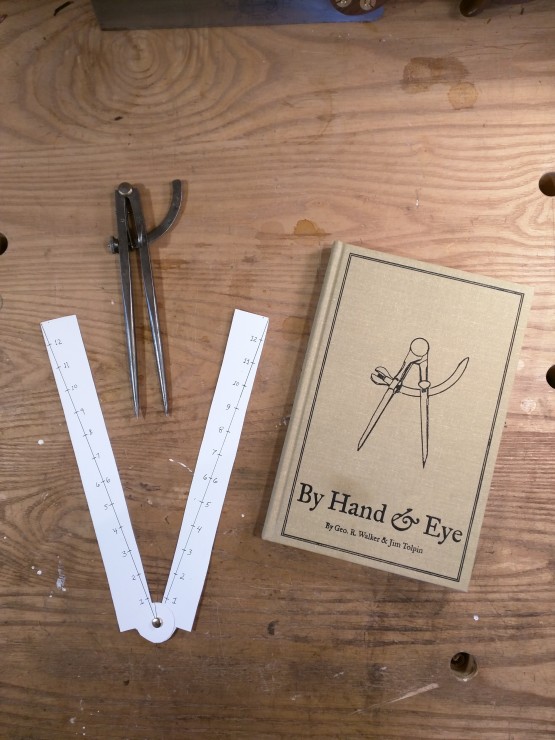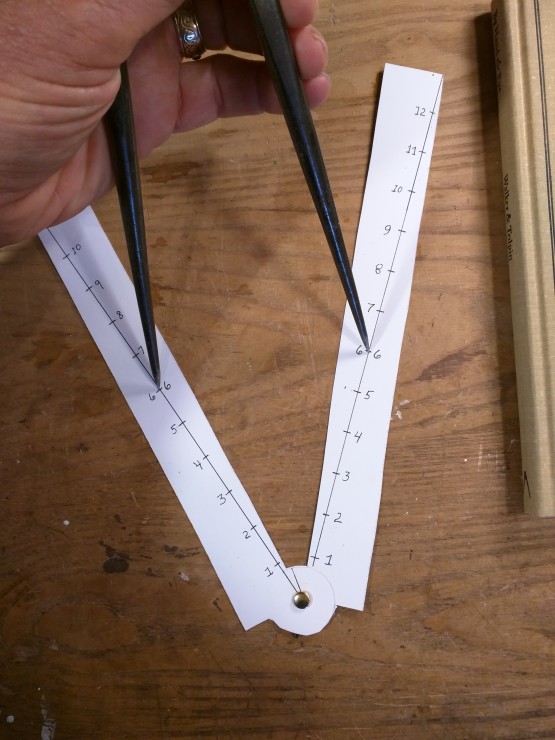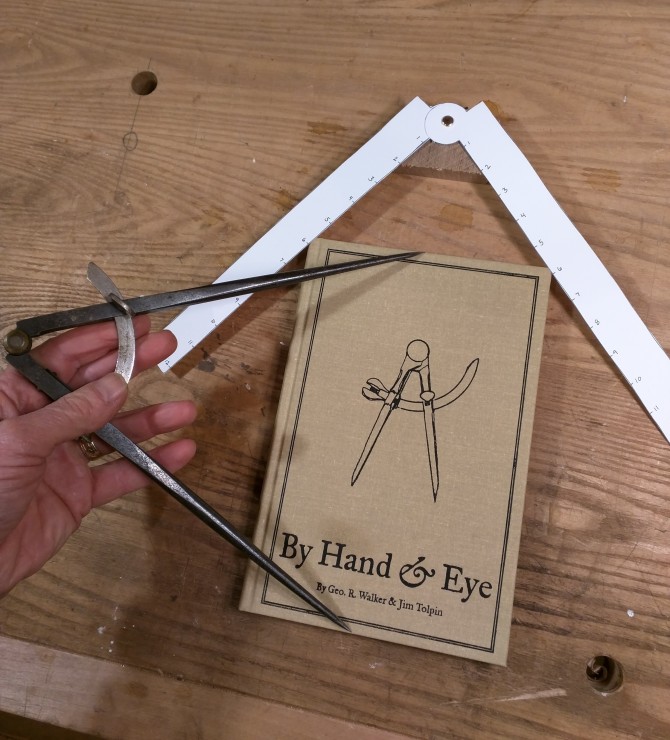A while back I noticed that a number of architect/builder’s sectors shown in manuscripts from the Renaissance era had the segmentation laid out along a diagonal line rather than along the inside edge of the legs. At first I thought this would limit the tool’s ability to directly (and therefore quickly) establish a whole number value across the width of a board. On reflection, I realized that you could simply transfer the wood’s width with witchcraft. I mean with a pair of dividers. (I must remember to turn off the automatic alliteration function in this word processor).

Let’s give this upgraded sector a shot, again using that handy little book as a product-placement prop.

Set your dividers to the width of the book.

Then spread the sector’s legs until the divider points fall on where the diagonal line crosses the sixth segment. If you make the sector in wood (you can use an old folding rule or make one from scratch) you can drill tiny pin holes at these locations to positively locate the divider points.

From here you’ll open up the dividers to span between the ninth intersections and then test the spread against the height of the book to discover the 6:9 (2:3) harmonic relationship:




13 thoughts on “That Snappy Sector Redux”
jwaldron
I am troubled by your witchcraft in the determination that the width of the book is 6 units. Unless your use of 6 is based on actual measurement of units (inches/cubits/miles/kilometers) it seems accessible only by serendipity or a lucky guess. If you had thought the width might be five or seven units, your result would have been quite different and rather more difficult to work with (7.5 or 10.5 units), even though in the correct proportion.
Jim Tolpin
My eye told me the proportions were likely in the Fibonacci series, of which 2:3 is the simplest to discern. Turned out to be right on.
jwaldron
Okay, I don’t mean to seem like a troll, but it twists my shorts a tiny bit that you “guessed” that the book proportion might be 2:3. But you might have reasonably guessed a ratio of 5:8 as the first step (5:8 is, after all, a fairly common ratio and not terribly far away from 2:3). In that case, your sector would have produced a spread for your dividers that wouldn’t work out in even unit steps. How about a session for those of us who are “guess impaired” on how to make a first guess or even a second guess that gets us closer to a more workable pair of whole number units?
Of course, the issue only applies when taking off proportions from a preexisting object. When designing, we get to choose our proportions and “move along,there’s nothing to see here.”
jglen490
O.K., I followed what you were doing – and it was making sense – and then the last picture put me into a loop. You start out with a sector that has the diagonal segment and do your measuring against that. Then, in the last picture you show the final step with a non-diagonal sector. What am i missing?
Jim Tolpin
I just noticed this as well. The sector was turned over inadvertantly for the last shot…the side that has the “line of lines” along the edge instead of along a diagonal line. Both work and both yield the same result. The edge marks are good for taking a quick reading, but harder to set the dividers to. An upgraded template for making your own sector is in the works and will be available soon.
jglen490
Thank you. After thinking about it, the diagonal marked sector and the edge marked sector each form a triangular shape. So as long as the marks on either are set equidistant, either one works. This is starting to make sense …
srgibson
I think I’m getting the idea of using a sector and dividers; I hope. I can see the advantages and look forward to putting theory to the test.
I have an old folding rule from which I will probably make a sector, but there is on thing I have not seen discussed. (I may have missed it.) When laying out the sector to measure both inside and outside dimensions, should the measure marks from edge to edge of the legs be perpendicular to the legs of the sector or to the diagonal line running the length? Which produces more accurate results when setting the dividers ?
Jim Tolpin
The most accurate and correct way is to swing arcs at the segment points on the diagonal line to either edge. Focal point is the pivot point of the sector arms. Don’t hesitate to ask for clarification if necessary.
srgibson
Makes perfect sense. Thank you.
billnm
Jim,
I am a sheet metal worker/coppersmith/cornice worker and I have bought your books and downloaded the pamphlets because I am excited at the possibilities that the sector and scale of chords offer to ease and speed up the layout process as it applies to my work.
That said, I have admired the vintage folding sectors on various tool sites, and as I am WAY too cheap to buy one of them, I aspire to make my own.
That poses the question: Am I correct in assuming that when I layout the various lines on my nice piece of brass they can be extended out as for as I might want as long as I keep the proportion of the spaces on all the line consistent the longer they get?
For example, can I extend the line of lines out to 26 as long as I keep the same distance between spaces? Or make the lines of polygons out as long as i wanted as long as I kept increasing the spaces by the proper ratio the further out the line goes?
I guess what I am really having a hard time understanding is, should the spaces on each line be considered as actual distances or should I be thinking of them as spaces set apart at a specific ratio to one another? Does that make sense?
Jim Tolpin
You have it right: you can make the sector scales to any length you want, you just need to maintain equal segmentation for the line of lines and you have to maintain the same proportional ratios for the other two scales. The line of circles is easy: the circumference to diameter ratio is 22 to 7. So you step out 22 segments to whatever length you want (on each leg of course) and mark the seventh line as the diameter index point. To stretch out the line of polygons, you have to construct a scale of chords where the chord line is the length you want to place on your sector legs. Then you just swing down the degrees (for each of the polygons) from the quadrant arc as described in the pamphlet. Hope that helps!
Evan
Jim-
Any chance we could get you to do a little blog on laying out the “fancy” sector? Cost aside of a vintage tools, I have noticed a sever lack of them even being offered. I have some nice Sassafras set aside a special projects, and a sector would be perfect.
Jim Tolpin
Free download of a three-scale sector on the shop page.